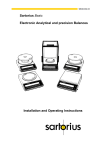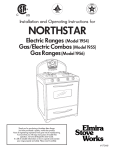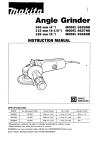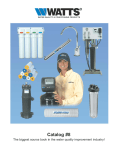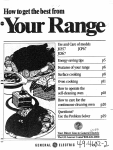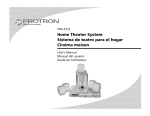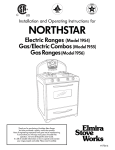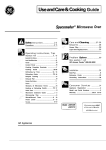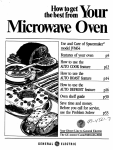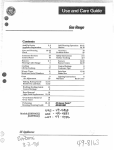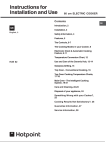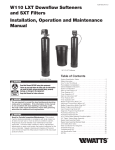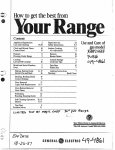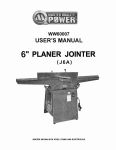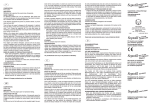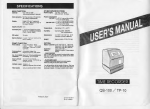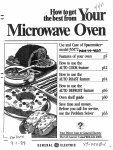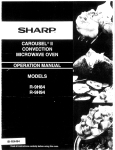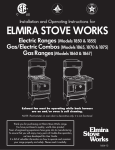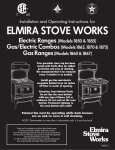Download GE JBP87GD User's Manual
Transcript
—
Features ofYour IFtmge-page 4
Energy saving l-ips-~~~~~~~~~~~
Use and Care ofYour
6, 7’,1’7
Ceramic cihoktop-pagp
Oven Cooking—pages 8=s11
Your
How toOperate
Self-Cleaning Oven—pages WU13
~~v~~
Save Time and IMcmy—
Before You Call W Service
(he ‘The Problem Solver—page 15
useand care
of
-:,-
L
Your
Thisuseandcare
to get the best performance from your range.
Take the time to read this book and learn how to
enjoy your new Range. It contains detailed operating instructions and recommended maintenance,
as well as handy tips to help you gain maximum
benefits from your Range. Once you have read the
book, keep it handy to answer any questions you
may have.
If you have any additional questions concerning the
operation of your Range, write—including your
phone number—to:
Consumer Affairs
General Electric Company
Appliance Park
Louisville, Kentucky 40225
IF YOU RECEIVED A DAMAGED RANGE, immediately contact the dealer (or builder) from whom
you purchased it. They have been informed of the
proper procedure to take care of such matters and
can handle it for you.
Your range has a nameplate on which is stamped the
model and serial numbers. (See page 4). Model and
serial numbers are also on the Purchase Record Card
which came with your range, Record the numbers in
the spaces provided below.
Please refer to both model and serial numbers in any
future correspondence or product service calls concerning your range.
Model Number
Serial Number
Date Purchased
KEEP PWW’’IASE F!ECE!PT Vim-4 THIS BOOK -m
ESTAF3LH-ITHE WVARFHWWPERIOD.
save
TimetmdIMoney—
Y(3Ucdl m’
Check “The Problem Solver”. (See page 15.) It lists
many minor causes of operating problems that you
can correct yourself and may save you an unnecessary service call.
Tips
Top-of-the”Range Ccmking
1. Use cooking utensils of medium weight aluminum, tight-fitting covers, and flat bottoms which
completely cover the heated portion of the surface
unit.
2. Cook fresh vegetables with a minimum amount
of water in 2 covered pan,
3. ‘*’Keep an eye” on foods when bringing them
quickly to cooking temperatures at HIGH heat.
When food reaches cooking temperature, reduce
heat immediately to lowest setting that will keep it
cooking.
4. Use residual heat with surface cooking whenever possible, For example, when cooking eggs in
the shell, bring water to boil, then turn to OFF position to complete the cooking.
5. Use correct heat for cooking task . ~. high heats
to start cooking (if time allows, do not use HIGH
heat to start), 7—quick brownings, 4—SIOW frying,
2—finish cooking most quantities, simmer—double
boiler heat, finish cooking, and special for small
quantities.
6. When boiling water for tea or coffee, heat only
the amount needed. It is not economical to boil a
container full of water for only one or two cups.
ovencooking
1. Preheat the oven only when necessary. Most
foods will cook satisfactorily without preheating. If
you find preheating is necessary, keep an eye on
the indicator light, and put food in the oven
promptly after the light goes out.
2. Always turn oven OFF before removing food.
3. During baking, avoid frequent door openings.
Keep door open as short a time as possible when it
is opened.
4. Be sure to wipe up excess spillage before selfcleaning operation.
5. Cook colmplete oven meals instead of just one
food item. Potatoes, other vegetables, and some
desserts will cook together with a main-dish casserole, meat loaf, chicken or roast. Choose foods that
cook at the same temperature and in approximately
the same time.
6. Use residual heat in oven whenever possible to
finish cooking casseroles, oven meals, etc. Also
add rolls or precooked desserts to warm oven,
using residual heat to warm them.
@1982General Electric Co., U.S.A. Al! rights reserved.
Before Using Your Range . . . . . . . . . . . . . . . . . . Inside Front Cover
Energy Saving Tips . . . . . . . . . . . . . . . . . . . . . . . Inside Front ~OVEW
Safety Tips . . . . . . . . . . . . . . . . . . . . . . . . . . . . . . . . . . . .. .........2-3
Features ofYour Range . . . . . . . . . . . . . . . . . . . . . . . . . . . . . . . . . . . . 4
Automatic Timer and Clocks . . . . . . . . . . . . . . . . . . . . . . . . . . . . . . . ~
.****.*.
O*.*.*** * 6
i-low To LJseYour Range Top.... ...*****
Care otYour Range Top . . . . . . . . . . . . . . . . . . . . . . . . . . . . . . . . . . . 7’
Using Your Oven .. .. .. .. .. .O. .. O.O...... .. .. ... ... ... .O... ~
l-iow To Bake and Time Bake. . . . . . . . . . . . . . . . . . . . . . . . . . . . . . . 9
How To Roast.... . . . . . . . . . . . . . . . . . . . . . . . . . . . . . . . . . . . . . . . . lo
.0..0.0 ..0.0.”.
******O *.* 11
How To13roil. . .0..,. .,,....0
How To Self-Clean Your Range . . . . . . . . . . . . . . . . . . . . . . . . . 12-13
How To Care ForYour Range . . . . . . . . . . . . . . . . . . . . . . . . . . . . . 14
The Problem Solver . . . . . . . . . . . . . . . . . . . . . . . . . ..*....*.***.
15
Cleaning Your Range Chart . . . . . . . . . . . . . . . . . . . . . . . . . . . . 16-17
18-19
Range Top Cooking Chart . . *.**.** .**.*.*.* .*...*.**
Baking Chart . . . . . . . . . . . . . . . . . . .. .. ... ... s.......
. . . . . . . . 2~
Roasting Chart . . . . . . . . . . . . . . . . . . . . . . . . . . . . . . . . . . . . . . . . . . . 21
22
*.***** ******. ,6...... .****.**
Broiling Chart . . . ..*..*.
24-25
*.***** ..*.***. .......0
IfYou Need Service . . . . ...*.*
Warranty . . . . . . . . . . . . . . . . . . . . . . . . .. .. .. ... ... ... .Back Cover
●
●
●
●
●
●
●
●
●
●
E&W-=
B
~-
●
●
●
——-
—.
1
——.—
.-
sheet cw flat tray.
grease outside a pan be put out by covering with
baking soda or, if available, a mL4Mpurpose dry chemical or foam.
@l Do not use your oven to dry news-papers. if overheated, they can catch
fire.
@$Do not store flammable materials in an
oven or near the Cooktopm
6$ Do not leg cooking grease or other
flammable materials accumulate in the
range or near it,
@ Have the installer show you the location
of the range circuit breaker or fuse, and
mark it for easy reference.
@ Have it installed and properly grounded
by a qualified installer.
!lMn’t leave children alone or mathmdd where a range is hot or in operation. They coukil be serkmsly burned.
Don’t allow anyone to climb, stand or
hang cm the door, drawer or range top.
They could damage the range and even
tip it over causing severe personal
injury.
CAUT’1ON: Do N(YT STORE’ ITEMS OF
iNTEREs’T To CHILDREN IN CABINETS
ABOVE A RANGE OR ON THE BACK”
SPLASH OF A RANGE–CHILDREN
CLJNIBING ON THE RANGE TO REACH
ITEMS
C(2LJILD BE SEFI [ C)USLY
1F4?JLJRED.
Do not touch heating elements or interior surface of oven. These surfaces
may be hot enough to burn even though
they are dark in color. During and after
use, do not touch, or let clothing or
other flammable materials contact surface cooking areas, areas nearby surface areas or any interior area of the
oven; allow sufficient time for cooling
first.
Potentially hot surfaces include the
cooktop and areas facing the cooktop,
oven vent opening and surfaces near
the openings, and crevices around the
oven door,
FMmernlmr: The inside surface of the
oven may be hot when the door is
opened.
Wear proper clothing, Loose fitting or
hanging garments should never be worn
while using the appliance.
Never use your appliance for warming
or heating the room.
Do not use vvater on grease fires. Never
pick up a
pan. !%nother
pan cm surface area by covering pan
with weil
Hd, cxmkie
Never leave surface cooking areas at
high heat settings. Boilover causes
smoking and greasy spillovers that may
catch on fire. Boil dry situations can
cause damage to utensil or glass surface area.
Only certain types of glass, glass/
ceramic, ceramic, earthenware, or other
glazed containers are suitable for rangetop service; others” may break because
of the sudden change in temperature.
(See Section on “How to LJse Your
Range-Top” for suggestions.)
Use only dry potholders—moist or
damp potholders on hot surfaces may
result in burns from steam. Do not let
potholders touch heated areas. Do not
use a towel or other bulky cloth.
To mirnirnbw burns, ignition of flammable materials, and spillage, the handle
of a container should be positioned so
that it is turned toward the center of the
range without extending over nearby
surface units.
Always turn surface unit to OFF before
removing utensil.
Keep an eye on foods being fried al
HIGH or MEDIUM HIGH heats.
Foods for fryhlg should be as dry as
possible. Frost on frozen foods or moisture on fresh foods can cause hot fat to
bubble up and over sides of pan,
LJse little fat for effective shallow or
deep-fat frying, Filling the pan too full of
fat can cause spillovers when food is
added.
2
—
if(xxl CCmtakfwsin
Don’t heat
the oven. Pressure could build up and
the
could burst causing an
injury.
When using cooking or roasting bags in
oven, follow the manufacturer’s directions.
If a combination of oils or fats will be
used in frying, stir together before
heating, or as fats melt slowly.
Always heat fat slowly, and watch as it
heats.
Use deep fat thermometer whenever
possible to prevent over-heating fat
beyond the smoking point.
Use Proper Pan Size—This appliance is
equipped with one or more surface
cooking areas of different size. Select
utensils having flat bottoms large enough
to cover the cooking area. The use of
undersized utensils will expose a portion of the surface cooking area to
direct contact and may result in ignition
of clothing.
Proper relationship
of
utensil to cooking area will also improve
efficiency.
When flaming foods under the hood,
turn the fan off. The fan, if operating,
may spread the flame.
Be sure vent duct k unobstructed.
Do not cook cm broken cooktop. If
cooktop should break, cleaning solutions and spiliovers may penetrate the
broken cooktop and create a shock
hazard. Contact a qualified technician
immediate y.
Clean cmktcm with caution. If a wet
sponge or cloth is used to wipe spills on
a hot cooking area, be careful to avoid
steam burn. Some cleansers can produce noxious fumes if applied to a hot
surface.
When cooking pork in oven, follow our
directions exactly and always cook the
meat to at ieast 170°. This assures that, in
the remote possibility that trichina may
be present in the meat, it will be killed and
meat will be safe to eat.
Don’t use aluminum foil anywhere on
the range except as described in this
book. Misuse could result in a shock,
fire hazard, or damage to the range.
Clean only parts listed in this Use &
Care Book.
Do not clean door gasket. The door
gasket is essential for a good seal. Care
should be taken not to rub, damage, or
move the gasket.
Before self-cleaning the oven, remove
broiler pan and other containers.
Do not use oven cleaners. No commercial oven cleaner or oven liner protective coating of any kind should be used
in or around any part of the oven.
Read “The Problem Solver” on page 15
of this book.
Don’t attempt to repair or replace any
part of your range unless it is specifically recommended in this book. All
other servicing should be referred to a
qualified technician.
Disconnect range at circuit breaker or
main fuse before-performing any service.
Stand away frcm the range when
opening cwen door. “he hot air or steam
which escapes can cause burns to the
hands, face and/or eyes.
Keep oven free from grease build up.
Place oven rack in desired position
while oven is cool. If racks must be
handled when hot, do not let potholder
contact heating units in the oven.
Pul!inq out shelf to the shelf stop is a
convefiience in lifting heavy food;. N is
also a precaution against burns from
touching hot surfaces of the door or
oven wails.
3
Your
10. GLASS-CERAMIC COOKING TOP. Cooking
areas are indicated by sunburst designs,
11. OVEN VENT !2.UCT.
12. IDOOR LATCH, Remains in COOK position
except when self-cleaning. See pages 12 and
13 for more information.
f13. OVEN LINER. Gray porcelain interior retains
heat and energy when cooking.
14. BROIL UNIT. When broiling, it radiates heat to
food surface. Also energized at low wattage
during baking to give balanced heating.
15. OVEN SHELVES. May be easily removed and
repositioned on shelf positions recommended
on Cooking Charts at the end of this book. May
be left in oven during self-cleaning function.
16. OVEN SHELF SUPPORTS. Indicate different
cooking positions by letters A, B, C and D. See
cooking charts for recommended positicns.
1. SURFACE UNIT CONTROLS. Push in to set.
2. INDICATOR LIGHT FOR SURFACE COOKING
AREAS.
3. OVEN SET (CLEAN) KNOB. Turn to desired
oven cooking function or to CLEAN position
when self-cleaning oven,
4. OVEN TEtUfP(CLEAN) KNOB. Turn to set oven
temperature, BROIL when broiling or to
CLEAN when self-cleaning oven.
5. OVEN CYCLING LIGHT. Light glows until
oven reaches selected temperature then goes
on and off during cooking with the oven units
as temperature is maintained.
& AUTOMATIC OVEN T!MEFl CLOCK AND
MINUTE TIMER. Use to set all oven timed
cooking functions and self-cleaning. (See page
5 for detailed information on setting.)
7. LATCH RELEASE. Push and hold in while
moving latch to CLEAN or COOK positions.
17. INTERIOR OVEN LIGHT. Automatically
on when oven door is opened,
turns
18. MODEL AND SERIAL NUMBER PLATE.Located
on right side of oven frame just below cooking
surface.
19. BROILER PAN AND RACK. Pan is used to
catch drippings, slotted rack supports food
and shields drippings or juices during broiling
or roasting to lessen spatters. DO NOT CLEAN
IN SELF-CLEAN OVEN.
20. OVEN FRAME.
21. WOVEN DOOR GASKET. Seals between oven
door and oven.
22. OVEN DOOR.
23. STORAGE DRAWER. Use to store utensils or
broiler pan and rack.
24. OVEN LIGHT SWKTCH, Use to turn interior
oven light on during cooking when door is
closed.
8. LOCKED LIGHT, Glows during self-cleaning
when oven has reached cleaning temperature.
Oven cannot be opened when this light is on.
25. BAKE IUNIT. During baking, it heats the air in
oven. May be gently lifted for cleaning,
9. OVEN CLEANING LIGHT. GIOYVSduring selfcleaning when all controls are set.
26, SURFACE LIGHT BUTTON. Push and hold
until surface dooking light comes on,
4
and
MINUTE -IVNIER
AND C“(XK SET-
TIME BAKE AND
SELF-CLEAN)ET
\
To
setckd’(
TO SET THE CLOCK, push in the center knob of
the Minute Timer and turn Knob in either direction.
(After setting the clock, let the knob out, and turn
the Minute Timer pointer to OFF.)
Time
Uses
Using Automatic Timer, you can TIME BAKE with
the oven starting immediately and turning off at the
Stop Time set or set both Start and Stop dials to
automatically start and stop oven at a later time of
day. It takes the worry out of not being home to
start or stop the oven and is also convenient for
parties when you must be gone before them.
Setting the dials for TiME BAKE is explained in
detail on page 9.
SM-ckan Lk?s
To
‘T’irner
set
The self-cleaning function on your range uses the
Automatic Timer to set the length of time needed to ‘clean whether you wish to clean immediately or
delay the cleaning. By setting the Start and/or Stop
Dials you may choose to begin immediately or clean
during the evening when energy rates are lower.
Full explanations of setting the Start and Stop Dials
for self-cleaning are described on pages 12 and 13.
The Minute Timer is the large dial to the left of the
digitai clock. Use it to time ail your precise cooking
operations. This dial also sets or changes the digital
clock.
TO SET THE MINUTE TIMER, turn the center knob
clockwise, without pushing in, until pointer reaches
number of minutes you wish to time (up to 60).
Q. How can I use my Minute Timer
to make my surface cooking easier?
A, Your Minute Timer will help
time total cooking which includes
time to boil food and change temperatures, Do not judge cooking
time by visible steam only. Food
will cook in covered containers
even though you can’t see any
steam.
Q. Must the Clock be set on correct time of day when I wish to use
the Automatic Timer for baking or
cleaning?
A. Yes, if you wish to set the Start
or Stop Dials to tllrn on and off at
set times during timed functions.
Q. Can I change the clock while
I’m cooking in the oven?
A. Yes, but if you are using a timed
cooking function, it is best to vvait
until finished cooking.
-–—-
Q. Can I use the Minute Timer
during oven cooking?
A. The Minute Timer can be used
during any cooking function, The
Automatic Timers (Start and Stop
Dials) are used with TIME BAKE
and SELF-CLEAN functions.
5
-.
Your
see
immge
Top
cooking
chart
on
pages
18
&79.
Your range top is designed to give you the flexibility
of boiling, steaming, sauteing, browning, frying,
canning, or pressure cooking, The heat is transferred from a heating element below the surface,
through the ceramic top, to the bottom of the
to
cooking utensil. This, in turn, heats the food. As it
heats, the cooking surface turns yellow. When the
control is turned to OFF, the cooking area cools
and returns to its original white color.
set
You must push the knob in only
when it is set at OFF; this is to prevent you from turning the knob on
accidentally. When the knob is in
any other position, you can turn it
without pushing it in. You will feel it
pop out when you turn it to OFF.
The lowest setting is between OFF
and WARM. At the HI setting, you
will feel the knob lightly click into
place.
In a quiet kitchen, you may hear
slight “popping” sounds during
cooking, indicating heat settings
are being maintained.
m
Step 1: Push in control knob.
HI
MED Hi
MED
Low
WM
Step 2: Turn the knob in either direction to the heat setting you
want.
Quick start for cooking; bring water to boil,
Fast fry, pan broil; maihtain fast boil on large
amount of food,
Saute and brown; maintain slow boil on large
amount of food.
Cook after starting at HIGH; cook with little water in
covered pan.
Steam rice, cereal; maintain serving temperature of
most foods.
@ Pots and pans should be flat on
the bottom and match the size of
the sunburst pattern. Large containers should be on large areas
and small ones on small areas.
@ It is important pans fit the areas
you are using, A pan smaller than
the heated area wastes power. A
frying pan or skiliet much larger
than the heated area may not heat
evenly.
o Center pots and pans on a cooking area which closely matches
the bottom of the utensil in size.
0 Containers of various materials
may require different heat settings
and/or cooking time. Check the
manufacturer’s instruction before
using.
@Special cooking equipment without flat bottoms, such as the
oriental wok, are not recommended
and could shorten the life of the
range top since high temperatures
are required in this type of cooking.
Wrong
mm
C,oncavc 130110m
Rounckd Boltom
Right
Wrong
NOTE:
1. AtHIGH,
RIED !-41,never leave food unattended. Boilovers
cause smoking; greasy spillovers may catch fire.
2. At WARM, LOW, melt chocolate, butter on small unit.
Right
~
@ Keep range and ventilating hood
free from grease accumulation.
@ When cooking is almost completed, use the retained heat to
finish cooking. Turn the knob to
OFF and leave the cooking utensil
in p~ace. When cooking area has
cooled, remove the utensil and the
cooked food.
e To prevent certain foods from
foaming, add a tablespoon of
cooking oil to the water before
cooking.
@Never leave food unattended
when you are cooking at HI or
i’vlED HI settings. Boi[overs cause
smoking and grease spillover may
catch fire.
6
NOT OVER 1$8
@ When canning foods, be sure to
check manufacturer’s instructions
and recipes, Be sure canner is flat-bottomed and fits securely over
center of cooking area.
Care
IT IS THE OWNER’S RESPONSIBILITY TO KEEP THE GLASS
COOKTOP FREE FROM DISCOLORATION
BY PROPER
MAINTENANCE IN ACCORDANCE WITH THESE INSTRUCTIONS, SINCE SOIL BUILD-UP IS THE ONLY CAUSE OF DISCOLORATION. THE GENERAL ELECTRIC WARRANTY DOES
NOT COVER DISCOLORATION OF THE COOKTOP, OR
SCRATCHING OR OTHER DAMAGE CAUSED BY IMPROPER
CLEANERS.
If not properly cared for, your
ceramic cooktop can become
stained and the original white
finish permanently
discolored.
Since soil build-up is the only
cause of discoloration, spatters
and spills must be cleaned up
properly. Heavy build-up can cause
a yellow or brown ish-grey glass
film even when the cooktop is
cool. However, the film is on the
surface only and can be removed.
To keep the ceramic cooktop looking like new, follow these steps.
Before first using the ceramic
cooktop, clean it with the CleanerConditioner packed in your range.
Step 1:Simply put a small amount
of cleaner directly on the center of
each sunburst pattern. Clean with
a damp paper towel. Wipe off with
another clean, damp cloth. Wipe
dry. NOTE: Use the Cleaner-Conditioner each day to remove all visible soil from the ceramic cooktop.
At least once a week, clean the
cooktop with Bar Keepers Friend@
Cleanser which is especially formulated for cleaning glass-ceramic
appliance tops and cookware.
~tep 2: To use, apply Bar Keepers
Friend@ to damp paper towel and
rub into stain until it is removed.
i3e sure cooking surface is cooled.
(For stubborn stains, apply a paste
of Bar Keepers Friend@ and water,
!/’
w’
cover with a wet paper towel, and
let stand for about 45 minutes.)
After using Bar Keepers Friend@,
aiways ciean with Cieaner-Conditioner foilowing directions in Step 1.
NOTE: The Cieaner-Conditioner
and Bar Keepers Friend@Cieanser
is soid in many grocery, hardware,
and department stores.
For other specific soils or scratches,
refer to page 17 entitied “GiassCeramic Cooktop.” This chart gives
probiems, causes, preventions, and
ways to best remove most stains.
Tips
@Do not ieave piastic items on
cooking area.
@Do not cook foods packaged
in their aiuminum foii trays or
wrapped in aiuminum foii on giass
ceramic. Foii can meit and fuse to
the u nit causing
permanent
damage.
e Keep bottom of utensii and
cooking surface ciean and dry. in
dusty or sandy areas, wipe the
utensii and cooking surface to prevent scratching the ceramic finish.
@Wipe up spiiis and spatters when
cooktop is cooi but before they
burn onto the surface. Be sure to
wipe area next to the unit you have
been using, in case food has spattered on these areas. CAUTiON:
Be carefui to avoid steam burns on
your hand when wiping the cooktop.
e Avoid scratching the cooktop
with rings or other jeweiry.
@During cooking, utensii iids coiiect condensed steam. if condensation drips on the cooktop,
minerai deposits in the water or
food can stain the cooking surface. Lift utensii iids so condensation drips back into the utensii instead of on,the cooktop.
o Use heat settings no higher than
MED or foiiow manufacturer’s directions when using utensiis made
of the foiiowing materiais: cast
iron, giass ceramic (pyroceram),
and stainiess steei. Aiso, enamelware which under certain conditions couid meit and fuse to the
cooking panei when higher heats
are used. Manufacturers of giass
cooking utensiis aiso recommend
using heats no higher than MED.
w’ Never use the ceramic cooktop
board.
Be sure the cooking top and surrounding areas
are cool before touching or cieaning. Even if
cooking surface has returned to its original
coior, aiiow a few minutes for cooling.
as a cutting
@ Dried boiiovers can cause permanent damage to
the ceramic cooktop. Take care to ciean up boiiovers prom ptiy.
When completely covered, the ceramic cooktop
can be used as a kitchen work surface. However,
be carefui not to scratch the top with sharp objects or utensiis that do not have smooth
bottoms.
w’ if the ceramic cooktop cracks or breaks, do not
use any part of it. Caii your service technician
promptiy.
7
Your
—
1. Look at the controls. Be sure you
understand how to set them properly. Read over the directions for the
Automatic Oven Timer so you
understand its use with the controls.
2. Check oven interior. Look at the
shelves. Take a practice run at removing and replacing them properly, to give sure sturdy support.
3. Read over information and tips
that follow.
4. Keep this book handy so you can
refer to it, especially during the first
weeks of getting acquainted with
your oven.
OVEN TEMP maintains the temperature you set from WARM
(150° ) to BROIL (550° ) and also at
CLEAN (880° ). The Oven Cycling
Light glows until oven reaches the
selected temperature, then goes
off and on with the oven unit(s)
during cooking. PRE-HEATING the
oven, even to high temperature
settings, is speedy—rarely more
than about 10 minutes. Preheat the
oven only when necessary. Most
foods will cook satisfactorily without preheating. If you find preheating is necessary, keep an eye
on the indicator light and put food
in the oven promptly after light
goes out.
Index Marker
The controls for the oven are
marked OVEN SET and OVEN
TEMP. OVEN SET has settings for
BAKE, TIME BAKE, BROIL, CLEAN
and OFF. When you turn the knob
to the desired setting, the proper’
heating units are then activated for
that operation.
~
The shelves are designed with
stop-locks so that when placed
correctly on the shelf supports, (a)
will stop before coming completely from the oven, (b) will not
tilt when removing food nor when
placing food on them.
TO REMOVE shelves from the
oven, when cool, lift up rear of
shelf, pull forward with stop-locks
(curved extension under shelf)
along tGp of shelf supports.
To REpLACE shelves in oven,
insert shelf with stop-locks resting
cm shelf supports. Push shelf
toward rear of oven; it will fall into
place. When shelf is in proper
position, stop-locks on shelf will
run under shelf support when shelf
is pulled forward.
Pointer
I
Oven Temp Setting for Normal Cooking
IMPORTANT: The OVEN TEfvlP
control has a blue pointer that is
used only for CLEAN. For normal
cooking, line up the desired temperatures (marked on the outer
edge of the control knob) with the
index marker located immediately
above the control.
For CLEAN, rotate the knob to the
right until blue pointer is pointing
up, toward Index Marker. When
position is reached, knob should
snap into position.
overt
The light comes on automatically
when the door is opened. Use
switch to turn light on and off
when door is closed.
Switch is in horizontal position on
right side of door under handle.
over
Lamp may be lighted by pressing
the lamp switch button, ‘Be sure t6
hold button depressed until light
comes on,
8
c-;
How
Bake
see
When cooking a food for the first
time in your new oven, use time
given on recipes as a guide. Oven
thermostats, over a period of
years, may “drift” from the factory
setting and differences in timing
between an old and a new oven of
5 to 10 minutes are not unusual
and you may be inclined to think
that the new oven is not performing correctly. However, your
new oven has been set correctly at
the factory and is more apt to be
accurate than the oven it replaced.
toset
for
Step 1: Place food in oven, being
certain to leave about l-inch of
space between pans and walls of
oven for good circulation of heat.
Close oven door. During baking,
avoid frequent door openings to
prevent undesirable results.
Step 2: Turn OVEN SET Knob to
BAKE and OVEN TElvlP Knob to
temperature on recipe or on Baking
Chart.
Step 3: Check food for doneness
at minimum time on recipe. Cook
longer if necessary. Switch off
heat and remove foods.
ILO
Time
Cm@ cmpage 20.
you set it to turn off automatically)
or Delay Start and Stop (setting
the oven to turn on automatically
at a later time and turn off at a
preset stop time) will be described.
I“ICN5J’
toset
NOTE: Before beginning make
sure the range clock shows the
correct time of day.
Immediate Start is simply setting
oven to start baking now and
turning off at a later time automatically. Remember, foods continue
cooking after controls are off.
Step 1: TO set Stop Time, push in
knob on STOP dial and turn
pointer to time you want oven to
turn off, for example 6:00. The
Start Dial should be at the same
position as the time of day on
clock.
Bake
Delay Start and Stop is setting the
oven timer to turn the oven on and
off automatically at a later time
than the present time of day.
Step 1: To set start time, push in
knob on START dial and turn
pointer to time you want oven to
turn on, for example 3:30.
Step 2: 1-0 set Stop Time, push in
knob on STOP dial and turn
pointer to time you want oven to
turn off, for example 6:00. This
means your recipe called for two
and one-half hours of baking time.
NOTE: Time on Stop Dial must be
later than time shown on range
clock and Start Dial.
—.——-.—
Step 2: Turn OVEN SET Knob to
TIME BAKE. Turn OVEN TEMP
Knob to oven temperature, for
example 250°.
The automatic oven timer controls
are designed to turn the oven on or
off automatically at specific times
that you set. Examples of immediate Start (oven turns on now and
step 3: Turn OVENSET Knob to
TIME BAKE. Turn OVEN TEMP
Knob to 250° or recoiiimended
temperature.
Place food in oven, close the door
and automatically the oven will be
turned on and off at the times you
have set. Turn OVEN SET to OFF
and remove food from oven.
NOTE: When setting oven for
Delay Start, Oven Indicator Light
comes on only when oven turns on.
9
.—
To
seeRoasting chart
Roasting is cooking by dry heat. Tender meat or
poultry can be, roasted uncovered in your oven.
Roasting temperatures, which should be low and
steady, keep spattering to a minimum. When
roasting, it is not necessary to sear, baste, cover, or
add water to your meat,
on
BxJqe
21,
Roasting is really a baking procedure used for
meats. Therefore, oven controls are set to BAKE.
(You may hear a slight clicking noise to indicate the
oven is working properly. ) Roasting is easy, just
follow these steps:
temperature is 5-10° F below temperature suggested on chart, If no
standing is planned, cook meat to
suggested temperature on chart
on page 21.
Step 1: Check weight of meat, and
place, fat side up, on roasting rack
in a shallow pan. (Broiler pan with
rack is a good pan for this. ) Line
broiler pan with aluminum foil
when using pan for marinating,
cooking with fruits, cooking heavily
cured meats, or for basting food
during cooking. Avoid spilling
these materials on oven liner or
door.
Step 2: Piace in oven on shelf in A
or B position. No preheating is
necessary.
Step’s: Turn OVEN SET to BAKE
and OVEN TEMP to 325°. Small
poultry may be cooked at 375° for
best browning,
NOTE: You may wish to use TIME
BAKE as described on preceding
page to turn oven on and off
automaticallyy,
For Frozen
Step 4: Most meats continue to
cook slightly while standing after
being removed from the oven. For
rare or medium internal doneness,
if meat is to stand 10-20 minutes
while making gravy or for easier
carving, you may wish to remove
meat from oven when internal
Frozen roasts of beef, pork,
lamb, etc., can be started without
thawing, but allow 10-25 minutes per pound additional time
(10 min. per pound for roasts
under 5 pounds, more time for
larger roasts),
Thaw most frozen poultry before
roasting to ensure even doneness. Some commercial frozen
poultry can be cooked successfully without thawing, Follow directions given on packer’s label,
.,
imd
Answers
Q. Is it necessary to check for
donerless with a meat thermometer?
A. Checking the finished internal
temperature at the completion of
cooking time is recommended.
Temperatures are shown on Roasting Chart on page 21, For roasts
over 8 Ibs., cooked at 300° with
reduced time, check with thermometer at half-hour intervals
after 1/2of time has passed
G. Why is my roast crumbling
when I try to carve it?
A. Roasts are easier to slice if
allowed to cool 10 to 20 minutes
after removing from oven. Be sure
to cut across the grain of the meat,
Q. Do 1 need to preheat my oven
each time I cook a roast or
poultry?
A. Itis rarely necessary to preheat
your oven, only for very small
roasts, which cook a short length
of time.
10
Q. When buying a roast are there
any special tips that would help
me cook it more evenly?
A. Yes, Buy a roast as even in
thickness ;S possible, or buy
rolled roasts.
Q. Can I seal the sides of my foil
“tent” when roasting a turkey?
A. Sealing the foil will steam the
meat. Leaving it unsealed allows
the air to circulate and brown the
meat,
—
seeEh’oiihcllchart
Broiling is cooking food by intense
radiant heat from the upper unit in
the oven. Most fish and tender cuts
of meat can be broiled. Follow
these steps to keep spattering and
smoking to a minimum.
OlnlDaae 22
Step 3: Position shelf on recommended shelf position as suggested on Broiling Chart on page
22. Most broiling is done on C
position, but if your range is connected to 208 volts, you may wish
to use D position.
Step 1: If meat has fat or gristle
near edge, cut vertical slashes
through both about 2-in. apart. If
desired fat may be trimmed, leaving
layer about 1/8-in. thick.
Qt’iestkms
and Answers
Q. Should I leave the door ajar
when broiling chicken?
A. No. The door should be closed
when cooking chicken and shelf
position “A” is recommended.
G?.May I use aluminum foil to line
the broiler pa~ and rack?
A. Yes, if you mold foil thoroughly
to broiler rack, slitting it to conform to slits in rack. Slits permit
proper drainage of meat juices
into broiler pan, minimizing smoking and spattering and preventing
possibility of fire from overheated
drippings. Do not place sheet of
(oil on oven shelf, To do so may
result in improperly cooked food
and possible damage to oven finish.
1:
I
, II
Step 4: Leave door ajar about 3
inches. The door stays open by
itself, yet the proper temperature
is maintained in the oven.
Step 2: Place meat on broiler rack
in broiler pan which comes with
range. Always use rack so fat drips
into broiler pan; otherwise juices
may become hot enough to catch
fire: Aluminum foil may be used to
line broiler pan and rack. But, be
CERTAIN to cut opening in foil, to
correspond with rack so fat drips
into pan below.
.+’/
Step & Turn food only once during
cooking. Time foods- for first side
as on Broiling Chart page 22. Turn
food, then use times given for
second side as a guide to preferred doneness. (Where two thicknessesand times are given together,
use first times given for thinnest
food.)
OVEN TEMP Knob to BROIL. Preheating unit is not necessary
except in areas of low power voltage. (See notes on Broiling Chart
page 22,)
Step 7: Turn OVEN SET Knob to
OFF. Serve food immediately, leave
pan outside oven to cool during
meal for easiest cleaning.
Q. Should I salt the meat before
broiling?
A. No. Salt draws out the juices
and allows them to evaporate.
Always salt after cooking. Turn
meat with tongs; piercing meat
with a fork also allows juices to
escape. When broiling poultry or
fish, brush each side often with
butter.
Q. When broiling, is it necessary to
always use a rack in the pan?
A. Yes+Using the rack suspends
the meat over the pan. As the meat
cooks, the juices fall into the pan
thus keeping meat dryer. Juices
are protected by the rack and stay
cooler, thus preventing excessive
spatter and smoking,
Ct. Do I need to grease my broiler
rack to prevent meat from sticking?
A. No. The broiler rack is designed
to ref Iect broiler heat thus keeping
the surface cool enough to prevent
meat sticking to the surface.
Q. Why are my meats not turning
out as brown as they should?
A. In some areas, the power (voltage) to the range may be iow. In
these cases, preheat the broii unit
for 10 minutes before piacing
broiier pan with food in oven.
Check to see if you are using the
recommended sheif position. Broii
for the longest period of time indicated in the Broii Chart in this
book. Turn food oniy once during
broiling.
—
Oven
VVhik
you are becoming acquainted with your selfcleaning oven, we recommend 2 hours for the modcrate soii condition, but in some cases a longer
cleaning time, up to 3 hours may be necessary. In
order to judge the degree of soil, look at the oven
floor and walls. Light spatter and thinner spi!ls
would generally need only 2 hours cleaning. Heavy
greasy spills and spatter on the oven interior would
need up to 3 hours.
STEP 4:
STEP 2:
Close oven door and make sure
oven light (D) is off.
Push and hold in LATCH RELEASE
BUTTON while sliding LATCH
HANDLE to the right until it is in
CLEAN position.
STEEPt:
Remove broiler pan, rack and
other cookware from the oven.
(Oven shelves may be left in oven.)
STEP 2:
Wipe up
bottom.
heavy
soil
on
oven
for
toset
STEP 1:
Turn OVEN SET and OVEN TEMP
knobs c!ockwhe to CLEAN. Controls will snap into final position
when the CLEAN location
is
reached.
STEP 3:
c
(Y
—
A. (hen Front Frame
l% Oven Door Gasket
C= Openings in Door
if% (hen Light
STEP 3:
Clean spatters or spills on oven
front frame (A) and oven door outside gasket (B) with a dampened
cioth. Polish with a dry cloth. Do
not clean gasket (B), Do not allow
water to run down through openings in top of door (C). Never use a
commercial oven cleaner in and
around self-cleaning oven.
12
Set the automatic oven timer:
Make sure both the range clock
and the START dial show the
correct time of day.
Decide on cleaning hours necessary—two hours for moderate
soil or three hours for heavy
soil.
Add these hours to present time
of day, then push in and turn
STOP (CLEAN) dial clockwise
to desired time. CLEANING
Light glows showing cleaning is
starting.
In about 30 minutes the LOCKED
Light glows indicating oven is
hot and door cannot be opened,
Oven door and window get hot
during self-cleaning. DO NOT
TOUCH.
—
STEP 2
STEP 1:
Turn OVEN SET Knob to OFF.
When LOCKED Light is off, push
and hold in LATCH RELEASE
Button
while sliding
LATCH
HANDLE to the left until it is in
COOK position.
Turn OVEN TEMP Knob to WARM,
STEP 3:
NOTE: If you wish to “start” and “stop” cleaning at a later time than shown on clock, ~ush in and turn START
diai to time you wish to “start”. Add the hours needed for cleaning to this “start” time, then push in and turn
STOP (CLEAN) dial to the desired time. Oven will automatically turn on and off at the set times.
Q. After having just used the oven,
the LOCKED Light came on and I
could
not move the LATCH
HANDLE. Why?
A. LOCKED Light glowing indicates that oven is hot. Open oven
door to cool the internal cavity.
After a short period of time, set up
controls for cleaning again.
Q. What sho~id I do if excessive
smoking occurs during cleaning?
A. This is caused by excessive soil
and you should switch the OVEN
SET Knob to OFF. Open windows
to rid room of smoke. Allow the
oven to cool for at least one hour
before opening the door. Wipe up
the excess soil and reset the clean
cycle.
Q. IS the “crackiing” sound I hear
during cleaning normal?
A. Yes. This is the metal heating
and cooling during both the cooking and cleaning functions,
Q. Why won’t my oven clean
jmrnediate[y even though I have
set ail the time and clean knobs
Check to be sure your START
dial is set to the same time as
RANGE CLOCK. Also check tO be
sure LATCH HANDLE is in CLEAN
pasi?ion.
Q. If my oven clock is not working
can I still self-clean my oven?
A. No. Your Automatic Oven Timer
uses the range clock to help start
and stop your self-cleaning cycle.
Q. Can I clean the Woven Gasket
around the oven door?
A. No, this gasket is essential for a
good oven seal and care must be
taken not to rub, damage or move
this gasket.
C?.Can I use commercial oven
cleaners on any part of my seif cleaning oven?
A. No cleaners or coatings should
be used around any part of this
oven. If you do use them and do
not wipe the oven absolutely
clean, the residue can scar the
oven surface and damage metal
parts the next time the oven is
automatically cleaned,
Q. What causes the hair-like lines
on the enameled surface of my
oven?”
A. This is a normal condition
resulting from heating and cooling
during cleaning. They do not
affect how your oven performs.
Q. Should there be any odor
during the cleaning?
A. Yes, there may be a slight odor
during the first few cleanings.
Failure to wipe out excessive soil
might also cause an odor when
cleaning.
Q. Why do I have ash left in my
oven after cleaning?
A. Some types of soil will leave a
deposit which is ash. It can be removed with a damp sponge or
cloth,
Q. MY own shelves do not slide
easily. What is the matter?
A. After many cleanings, oven
shelves may become so clean they
do not slide easily. If you wish
shelves to SIide more easily,
dampen fingertips with a small
amount of cooking oil and rub
lightly over sides of shelf where
they contact shelf supports.
Q. My oven shelves have become
gray after several cleanings. Is this
normal?
A= Yes, A~ier many cleanings, the
shelves may lose some luster and
discolor to a deep gray color.
Q. I hear a humming noise during
cleaning. Is this normal?
A. Yes. The noise you hear is a fan
running during cleaning,
——
—
How
The porcelain enamel finish is
sturdy but breakable if misused.
This finish is acid resistant. However, any acid foods spilled (such
as fruit juices, tomato, or vinegar)
should not be permitted to remain
on the finish.
-=
x(’7J~
jA!c21==
L)gyo
J!
OVEN VENT OUCT
I
/
,----------
\
, .,
Your oven is vented through an
opening located under the center
of the control panel.
During most operations it is normal
to observe moisture and/or vapor
emitting from opening. Clean this
area frequently.
NOTE: NEVER COVER OR BLOCK
VENT OPENING. TO DO SO PRE-VENTS THE OVEN VENT FROM
FUNCTIONING PROPERLY DURING COOKING OR SELF-CLEANING OPERATIONS.
Lamp and
CAUTION: Before replacing your
oven bulb, disconnect the electrical power for your range at the
main fuse or circuit breaker panel
or pull plug. Be sure to let the la,mp
cover and bulb coo! completely
before removing or replacing,
To Remove:
@Remove the 3 siotted screws in
the lamp cover as shown in
diagram,
@Detach lamp cover and remove
bulb.
,To Replace:
@ Put in a new 40-watt appliance
bulb.
o Install lamp cover. Replace 3
screws and tighten, making sure
cover fits flush with oven wall.
0 Reconnect electrical power to
the range.
Use time given on recipe when
cooking first time. Oven thermostats, in time, may “drift” from the
factory setting and differences in
timing between an old and a new
oven of 5 to 10 minutes are not
unusual. Your oven has been set
correctly at the factory and is more
apt to be accurate than the oven
which it replaced. However, if you
find that your foods consistently
brww too little or too much, you
may make a simple adjustment in
the thermostat (Oven Temp) knob.
PULL KNOB OFF OF SHAFT, LOOK
AT ‘BACK OF KNOB AND NOTE
CURRENT SETTING, BEFORE
MAKING ANY ADJUSTMENT.
To increase temperature, turn
toward RAISE; to decrease turn
toward
LOWER. Each notch
changes temperature 10 degrees.
Temperature can be raised by 20
degrees or lowered by 30 degrees.
WHEN CHANGING A COOKTOP
LAMP, DO NOT TOUCH THE
METAL AT ENDS OF LAMP,
a. Remove Phillips head screws at
each end of cover.
b. Place finger% on top near each
end of lamp. Press down and roil
top of lamp gently toward front of
range until it stops. Remove.
c. Check type and wattage of
lamp; replace with same kind.
Hold lamp near each end and insert prongs into sockets. Gently
roll top of lamp toward rear of
range until it stops.
CL Replace lamp cover and screws.
e. Connect electric power to range,
1. Remove knob, and hold so
pointer is at top of knob, Using a
pot holder or similar material, hold
“skirt” of knob firmly in one hand.
Grasp handle of knob in other hand.
Note position of pointer and turn
handle to move pointer toward
Raise or Lower. Pointer is designed
not to move easily. If it is seated so
it is difficult to move, pointer may
be loosened slightly. Insert a thin
screwdriver, knife blade or similar
instrument and lift up end of
pointer slightly.
2. After adjustment is made, press
monitor firmly against knob. Return
knob to range, matching flat area
on knob and shaft. Recheck oven
performance before making an
additional adjustment.
14
-—
=
The
To
if you have a problem, it may be minor. You may be able to correct it yourself. Just use this Problem Solver to
locate your problem and then follow the suggested recommendations,
Rxxii Is Not Eh3kirIgProperly:
Chm’liC)peraticm
own will
Not
work:
BAKE controls not set properly.
Oven shelf is not level.
Rack is not on correct shelf position.
The wrong cookware is being used.
Too many utensils in the oven.
Temperature setting is incorrect.
e Plug on range is not completely inserted in the
outlet receptacle.
@ The circuit breaker in your house has been
tripped, or a fuse has been blown.
@ Oven controls are not properly set.
@ Door left in locked position after cleaning,
Seif”clearl Opei%mn
oven Light Does hh3t Work:
oven WWiU
Not SeWClear9:
e Light bulb is loose.
e Bulb is defective.
@ Switch operating oven light is broken.
Failure to set Automatic Timer dial/dials. The
STOP dial must be set and advanced beyond the
time noted on range clock.
The STOP dial was not advanced for long enough
time.
Both OVEN SET and OVEN TEMP must be at
CLEAN setting.
A thick pile of spillover when cleaned leaves a
heavy layer of ash in spots which could have insulated the area from further heat.
~00~ Does Not Broil Properly:
@ OVEN TEMP not set at BROIL.
e Improper shelf position is being used.
@ Necessary. .preheating was not done.
@ Utensils are not suited for broiling.
@ Aluminum foil used on the broil pan rack has not
been fitted properly and slit.
Oven Door Won’t Latch:
@ Turn OVEN SET Knob to CLEAN. Glcwing
Food is Not Roasting Properly:
OVEN SET Knob not set on BAKE.
Oven Temperature not set correctly.
Shelf position is incorrect.
Roasting pan is too small.
Improper cookware is being used.
A foil tent was not used when needed to slow
down browning.
Locked Light after knob is turned shows oven is
too hot from previous oven use and door won’t
latch. Open door wide so oven can cool, then
latch can be moved.
o OVEN SET Knob must be at CLEAN or OFF
before latch can be moved.
—
15
Your Range is cleaned two ways; manually and by
using the automatic self-cleaning function. This
chart describes parts of your range, cleaning materials to use on each part, and general directions for
Gemmd Directions
F%w’t
I!3dte Wit
am.fBroil
Do not clean the bake unit or broil unit. Any soil will burn off
when the unit is heated. NOTE: The bake unit is hinged and can
be lifted gently to clean the oven floor, If spillover, residue, or ash
accumulates around the bake unit, gently wipe around the unit
with warm water,
Unit
Broiler Pm and Rack
@Soap and Water
e Soap-Filled Scouring Pad
● plastic
scouring
pad
(20ritro! !hoim: Range Top
and oven
Outside
cleaning. Be sure to follow these directions carefully
to assure maximum use of your range. NOTE: Let
range parts COOIbefore cleaning manualiy.
Drain fat, cool pan and rack slightly. (Do not let soiled pan and
rack stand in oven to cool), Sprinkle on detergent, Fill the pan
with warm water and spread c!otn or paper towel over the rack.
Let pan and rack stand for a few’minutes. Wash; scour if necessary. Rinse and dry. OPTION: The broiler pan and rack may also
be cleaned in a dishwasher.
●
Mild Soap and Water
Pull off knobs. Wash gently but do not soak. Dry and return controls to range making sure to match flat area on the knob and
shaft.
●
Soap and Water
Wash all glass with cloth dampened in soapy water. Rinse and
polish with a dry cloth, if knobs are removed, do not let water rur
down inside surface of glass,
Wash, rinse then polish with dry cloth, DO NOT USE steel wool,
abrasives, ammonia, acids or commercial oven cleaners which
may damage finish,
Avoid cleaning powders or harsh abrasives which may scratch the
enamel.
If acids should spill on the range while it is hot, use a dry paper
towel or cloth to wipe up right away. When the surface has
cooled, wash and rinse.
For other spills, such as fat smatterings, etc., wash with soap and
water when cooled and then rinse. Polish with a dry cloth.
Finish
Glass
Metal, including Brushed
Chrome and Cooktop
~ Soap and Water
Porcelain Enamel*
@Paper Towel
~ Dry Cloth
o Soap and Water
#nSideOven Door*
o Soap and Water
On self-cleaning oven, clean ONLY the door liner outside the
gasket, The door is automatically cleaned if the oven is in the selfcleaning cycle. If spillover or spattering should occur in cooking
function, wipe the door with soap and water, DO NOT rub or
damage gasket, Avoid getting soap and water on the gasket or in
the slots on the door;
Avoid getting ANY cleaning materials on the gasket,
SheEwes
(See Self-Cleaning Oven
Directions)
@Soap and Water
Cool before cleaning. Frequent wiping with mild soap and water
will prolong the time between major cleanings, Be sure to rinse
thoroughly, For heavy soiling, use your self-cleaning cycle often,
~ Soap and Water
Your shelves can be cleaned with the self-cleaning function in the
oven. For heavy soil, clean by hand using any and all mentioned
materials, Rinse thoroughly to remove all materials after cleanirig,
~ Soap and Water
For cleaning, remove drawer by pulling it all the way open, tilt up
the front and lift out, Wipe with damp cloth or sponge and
replace, Never use harsh abrasives or scouring pads.
*Spillage of marinades, fruit juices,and basting matwials containing acids maycausediscoloration. Spilloversshould be cleanedWI
imrnediateJy with a paper towel. When the surface is cool, clean an-d rinse,
-
16
—
Brown streaks
and specks
Cleaning with a sponge or
dishcloth that has been used
for other kitchen cleaning
tasks and may contain soilIaden detergent water.
Use Cleaner-Conditioner only
with clean, damp paper towel.
Use a light application of Cleaner-Conditioner
with clean, damp paper towel.
Blackened
Burned-on
spots
Spatters or spiliovers
which contact hot
cooking area.
Whenever possible, wipe
spatters and food spills as
they occur.
Select correct heat settings
and large enough cookware to
eliminate boilovers and
spattering.
CAUTION: Be careful to avoid
steam burns.
Be sure unit is COOJ
before
putting these items on
cooking surface.
When area has cooled:
Use Cleaner-Conditioner with damp paper towel
to remove as much burn-on as possible.
Use Cleaner-Conditioner with nonimpregnated
plastic nylon pads, such as: Dobie scouring pad,
Skruffy scouring brush, Tuffy plastic mesh ball.
Accidental melting of a
plastic film such as a
bread bag or similar
items.
If burn-on persists, CAREFULLY scrape with a
single-edge razor blade. Hold blade so edge is
completely flat on cooktop and blade is a 30°
angle.
Fine “brown
lines” (tiny
scratches or
abrasions whict
have collected
soil).
Coarse particles (salt,
sand, sugar or grit)
caught between bottom
of cookware and cooktop
that are not removed
before cooking.
Using incorrect cleaning
materials.
Normal daily use of CleanerConditioner.
In area where there is an
abundance of sand or dust,
be sure to wipe cooktop
before using,
Use only cleaning materials
recommended in this manual.
Tiny scratches are not removable but can be
minimized by continual use of CIeanerConditioner. Such scratches do not affect
cooking performance,
Metal marking
(l#rjs;r black
. .
Sliding or scraping metal
utensils or oven shelf
racks across cooktop.
Do not slide racks or other
sharp metal objects across
cooktop.
Apply Cleaner-Conditioner with dampened paper
towel to cooled surface.
Pitting or
spalling
Boil over of sugar syrup
and adherence of sugar
syrup to hot cooktop.
Select correct heat setting and
large enough cookware to
eliminate boilovers and
spattering,
Watch sugar syrup carefully
to avoid boilover.
While unit is still hot turn to OFF; wrap several
damp paper towels around spatula or pancake
turner and useto removesugarsyrupspi//from
Hardvvater spots
(a gray or brown
stain that does
not seem to be
removed using
CleanerConditioner)
In cooking, condensation
often collects and drips
when covers are removed.
The minerals found in the
water supply and in foods
may cause mineral deposits
to turn a gray or brown color
The layer is so thin it often
seems to be in or under
the cooking surface and
cannot readily be felt,
Daily use of CleanerConditioner applied with a
clean, damp paper towel will
help to keep the glass-ceramic
surface free from hardwater
mineral deposits.
/70tcooktopirrrrned’ately.
CAUTION: Sugar syrup is very hot so be careful
not to burn yourself.
Scrape off remainder of burn with single-edge
razor blade while unit is still warm—before
cooling down completely. Hold blade so edge is
completely flat on cooktop and blade is at a 30°
angle.
Mix a small amount of Bar Keepers Friend@
Cleanser with tap water to form a thick, wet
paste.
Apply this mixture to stain area.
Let it stand 45 minutes.
Scrub with clean, damp paper towel.
After stain is removed:
Wipe up remaining paste with damp paper towel.
Apply dab of Cleanser-Conditioner and polish
with paper towel.
w##-
‘Ea
—
—
—
areas, small pans on small areas), Utensils should
rest level on the cooking area with or without food
in them or covers on them, and entire bottom of
pan should touch heated area evenly to eliminate
“hot spots.”
4. Use small cooking areas for small utensils, large
cooking areas for large utensils. The use of a
utensil smaller than the size of the cooking area will
expose a portion of the heated area to direct contact by the user. This condition could result in
1. Make sure bottom of utensil and cooking panel
are clean and dry. In dusty or sandy areas, wipe
cooking panel and utensil before using to prevent
scratching the glass ceramic finish.
2. Center utensil on a cooking area which most
nearly matches bottom of utensil in size.
3. Utensils should be flat on bottom and should
match size of cooking area (large pans on large
—.
Birectioms and Setting
to Start Choking
Setting to Complete
Cooking
Comments
Fod
Container
Cereal
Cornmeal, grits,
oatmeal
Covered
Saucepan
H1. In covered pan bring
water to boil before adding
cereal.
:
LOW or WM, then add
cereal, Finish timing
according to package
directions.
Cereals bubble and expand as
they cook; use large enough
saucepan to prevent boilover.
Uncovered
Saucepan
H1. Stir together water or
milk, cocoa ingredients.
Bring just to a boil.
MED, to cook 1 or 2 min.
to completely blend
ingredients.
Milk boils over rapidly. Watch
as boiling point approaches.
Percolator
HI, At first perk, switch
heat to LOW.
LOW to maintain gentle
but steady perk,
Percolate 8 to 10 min. for 8
cups, less for fewer cups.
Covered
Sauce@an
Hl, Cover eggs with cool
water. Cover pan, cook
until steaming.
MED H1. Me!t butter, add
eggs and cover skillet.
LOW. Cook only 3 to 4
min. for soft cooked; 15
min. for hard cooked,
Continue cooking at MED
HI until whites are just set,
about 3 to 5 min.
LOW, then add eggs,
When bottoms of eggs
have just set, carefully
turn over to cook other
side.
LOW, Carefully add eggs,
Cook uncovered about 5
rein, at MED Ht.
MECI.Add egg mixture,
Cook, stirring to desired
doneness,
Coffee
Eggs
Cooked in shell
Fried sunny-side-up
Covered
Skillet
Fried over easy
Uncovered
Skillet
Ht. Melt butter.
Poached
Covered
Skillet
H1. In covered pan bring
water to a boil,
Scrambled or omelets
Uncovered
Skillet
l-ii, Heat butter until light
golden in color.
Covered
Saucepan
Hi. In covered pan bring
fruit and water to boil.
LOW. Stir occasionally
and check for sticking.
Meats, Fbullry
Braised: Pot roasts of
beef, lamb or veal;
pork steaks and
chops
Covered
Skillet
Ht. Melt fat then add meat.
Switch to MED HI to
brown meat, Add water or
other liquid.
LOW. Simmer until fork
tender.
Pan-irled: Tender
chops; thin steaks up
!G 3/6-\ f_I.; rninUte
steaks; hamburgers;
franks; and sausage:
thin ttsh fillets.
—.
Uncovered
Skillet
HI Preheat skillet, then
grease lightly.
MED HI or MED. Brown
and cook to desired
doneness, turning over as
needed.
—-
—.
.
If you do not cover skillet,
baste eggs with fat to cook
tops evenly,
Remove cooked eggs with
slotted spoon or pancake
turner,
Eggs continue to set slightly
after cooking. For omelet do
not stir last few minutes.
When set fold in half.
Fresh fruit: Use 1Ato % cup
water per pound of fruit.
Dried fruit: Use water as
package directs. Time
depends on whether fruit has
been presoaked. If not, allow
more cooking time.
Meat can be seasoned and
floured before it is browned, if
desired.
Liquid variations for flavor
could be wine, fruit or tomato
juice or meat broth,
Timing: Steaks 1 to 2-in,: 1 to
2 hrs. Beef Stew: 2 to 3 hrs.
Pot roast: 2M to 4 hrs,
Pan frying is best for thin
steaks and chops, If rare is
desired, preheat skillet before
adding meat,
serious burns or clothing ignition accidents.
5. Use heat settings no higher than MED or follow
manufacturer’s directions when using utensils
made of the following materials: cast iron, glass
ceramic (pyroceram), and stainless steel. Also,
enamelware which under certain conditions could
melt and fuse to the cooking panel when higher
heats are used. Manufacturers of glass cooking
utensils also recommend using heats no higher
than MED.
w
m
‘~GHT
DirectiIomf.3 and Setting
to start cooking
Food
b’G-zR,.
settingto Cemphxe
cooking
Cmlmm?fhts
Fried Chicken
Covered
Skillet
Hi. Melt fat. Switch to MED
HI to brown chicken,
LOW.Cover skillet and
cook until tender.
Uncover last few minutes.
Pan broiled bacon
Uncovered
Skillet
MED H1.Cook, turning
over as needed.
Sauteed: Less tender
thin steaks (chuck,
round, etc.); liver;
thick or whole fish
Covered
Skillet
H1. In cold skillet arrange
bacon slices. Cook just
until starting to sizzle.
H1. Melt fat. Switch to MECI
to brown slowly.
For crisp dry chicken, cover
only after switching to LOW
for 10 min. Uncover and cook
turning occasionally 10 to 20
min.
A more attention-free method
is to start and cook at MED.
LOW, Cover and cook
until tender.
Meat may be breaded or marinated in sauce before frying.
Simmered or stewed
meat; chicken; corned
beef; smoked pork;
stewing beef; tongue;
etc.
Covered
Dutch Oven,
Kettle or
Large
Saucepan
H1. Cover meat with water
and cover pan or kettle.
Cook until steaming.
LOW. Cook until fork
tender. (Water should
slowly boil). For very large
loads medium heat may
be needed.
Add salt or other seasoning
before cooking if meat has not
been smoked or otherwise
cured.
Melting chocolate,
butter,
marshmallows
Small
Govered
saucepan.
Use small
surface unil
WM. Allow 10 to 15 min. to
melt through. Stir to
smooth.
Pancakes or
French toast
Skillet or
Griddle
MED Hi. Heat skillet 8 to
10 min. Grease lightly,
Cook 2 to 3 min. per side.
Thick batter takes slightly
longer time, Turn over pancakes when bubbles rise to
surface.
Covered
Large Kettle
or Pot
Hi. In covered kettle, bring
salted water to a boil,
uncover and add pasta
slowly so boiling does not
Stop.
MED Hi.. Cook uncovered
until tender, For large
amounts HI may be
needed to keep water at
rolling boil throughout
entire cooking time.
Use large enough kettle to
prevent boilover. Pasta doubles in size when cooked,
Pressure Cooking
Pressure
Cooker or
Canner
H1. Heat until first jiggle is
heard.
MED HI for foods cooking
10 min. or less, MED for
foods over 10 min.
Cooker should jiggle 2 to 3
times per minute.
Puddings, !%uces,
Candies, Frostings
Uncovered
Saucepan
HI. Bring just to boil,
LOW, To finish cooking.
Stir frequently to prevent
sticking.
vegetables
Fresh
Covered
Saucepan
MED. Cook l-lb, 10 to 30
more min,, depending on
tenderness of vegetable,
Uncovered pan requires more
water and longer time,
Frozen
Covered
Saucepan
LOW. Cook according to
time on package.
Break up or stir as needed
while cooking,
Sauteed: Onions;
green peppers; mushrooms: celery; etc.
Jncovered
Skillet
Ht. Measure Vzto l-in.
water in saucepan. Add
salt and prepared vegetable, In covered saucepan
bring to boil.
HI, Measure water and salt
as above. Add frozen block
of vegetable, In covered
saucepan bring to boil,
Hl, In skillet melt fat,
MED. Add vegetable.
Cook until desired tenderness is reached,
Turn over or stir vegetable as
necessary for even browning,
Rice and Grits
Oovered
Saucepan
WM. Cover and cook
according to time,
Triples in volume after
cooking, Time at WM. Rice: 1
cup rice and 2 cups water—25
reins. Grits: 1 cup grits and 4
cups water-40 min.
Pasta
Noodles or spaghetti
.—
H1.Bring salted water to a
boil.
—
When melting marshmallows,
add milk or water.
—.
19
—.
—
q. Aluminum pans conduct heat quickly. For most conventional
baking light shiny finishes give best results because they prevent overbrowning in the time it takes for heat to cook the center
areas. Dull (satin-finish) bottom surfaces of pans are recommended for cake pans and pie plates to be sure those areas
brown completely.
Z!. Dark or non-shiny finishes, also glass and pyroceram, absorb
heat which may result in dry, crisp crusts. Reduce oven heat 25°
if lighter crusts are desired. Preheat cast iron for baking some
foods for rapid browning when food is added.
& Preheating the oven is not always necessary, especially for
foods which cook longer than 30 or 40 minutes. For food with
short cooking times, preheating gives best appearance and
crispness,
& Open the oven door to check food as little as possible to
prevent uneven heating and to save energy.
SIwm
own
Food
Container
Position
—.
Temp.
Ti??m+
Min.
Bread
Biscuits (%-in. thick)
Shiny Cookie Sheet
B, C
400°-4750
15-20
B, A
350°-4000
20-30
B
B
400°-4500
350°
20-40
45-55
Preheat pan for crisp crust.
Muffins
Popovers
Shiny Metal Pan with
Satin-finish bottom
Cast Iron or Glass
Shiny Metal Pan with
Satin-finish bottom
Shiny Metal Muffin Pans
Deep Glass or Cast Iron Cups
A, B
B
400°-4250
375°
20-30
45-60
Decrease about 5 min. for muffin
mix. Or bake at 450° for 25 min.,
then at 350° for 10-15 min.
Quick Loaf Bread
Yeast bread (2 loaves)
Metal or Glass Loaf Pans
Metal or Glass Loaf Pans
B
A, B
350°-3750
375°-4250
45-60
45-60
Plain rolls
Sweet rolls
Shiny Oblong or Muffin Pans
Shiny Oblong or Muffin Pans
A, B
B, A
375°-4250
350°-3750
10-25
20-30
cakes
(without shortening)
Angel food
Jelly roll
Sponge
Aluminum Tube Pan
Metal Jelly Roll Pan
Metal or Ceramic Pan
A
B
A
325°-3750
375°-4000
325°-3500
30-55
10-15
45-60
cakes
Bundt cakes
Cupcakes
Metal or Ceramic Pan
Shiny Meta{ Muffin Pans
A, B
B
325°-3500
350°-3750
45:65
20-25
A, B
275°-3000
2-4 hrs
B
350°-3750
20-35
B
350°-3750
25-30
Loaf
btetal or Glass Loaf or
Tube Pan
Shiny Metal Pan with
Satin-finish bottom
Shiny Metal Pan with
Satin-finish bottom
Metal or Glass Loaf Pans
B
350°
40-60
Cookies
Brownies
Drop
vletal or Glass Pans
:ookie Sheet
8, c
B, C
325°-3500
350°-4000
25-35
10-20
Refrigerator
Rolled or sliced
2ookie Sheet
2ookie Sheet
B, C
B, C
4000-4250
375°-4000
6-12
7-12
A, B, C
B
350°-4000
300°-3500
30-60
30-60
Puddings, Rice and
Custard
~lass or Metal
;Iass Custard Cups or
>asserole (set in pan of
lot water)
;Iass Custard Cups or
>asserole
B
325°
50-90
Piim
Frozen
‘oil Pan on Cookie Sheet
A
400°-4250
45-70
Meringue
lpread to crust edges
B, A
325°-3500
15-25
One crust
Two crust
Pastry Shell
?JIassor Satin-finish Metal
;Iass or Satin-finish Metal
;Iass or Satin-finish Metal
A, B
B
B
400°-4250
400°-4250
450°
45-60
40-60
12-15
Baked potatoes
Scalloped dishes
%~fff Ies
;et on Oven Shelf
~lass or Metal
~lass
4, B, C
4, B, C
B
325°-4000
325”-375°
300°-3500
60-90
30-60
30-75
Coffee cake
Corn bread or muffins
Gingerbread
Fruit cakes
Layer
Layer, Chocolate
Fruits,
other Desserts
Baked apples
Custard
20
Comments
Canned refrigerated biscuits take
2-4 min. less time.
Dark.metal or glass give deepest
browning.
For thin rolls, Shelf B may be used.
For thin rolls, Shelf B may be used.
Two piece pan is convenient.
Line pan with waxed paper.
Paper !iners produce more moist
crusts.
Lfse 300° and Shelf B for small or
individual cakes.
Bar cookies from mix use same
time. Use Shelf C and increase
temp. 25-50° for more browning,
Reduce temp. to 300° for large
custard. Cook bread or rice pudding
with custard base 80 to 90 minutes,
Large pies use 400° and increase
time.
To quickly brown meringue use
400° for 8-10 min.
Custard fillings require lower temp.,
longer time,
Increase time for large amount or
size.
.—
‘f. pOSitiOnoven shelf at B for small-size roasts (3 to 7 Ibs.) and
at A for larger roasts.
Z?.Place meat fat side up or poultry breast-side up on broiler
pan or other shallow pan with trivet. Do not cover. Do not stuff
poultry until just before roasting. Use meat probe, for most
accurate doneness. Control signals when food has reached set
temperature. (Do not place probe in stuff ing. )
3. Remove fat and drippings as necessary. Baste as desired.
Type
oven
Temp.
4. St.mding time recommended for roasts is 10 to 20 min. to
allow roast to firm up and make it easier to carve. It will rise
about 5° to 10° internal temperature; to compensate for temperature rise, if desired, remove roast from oven at 5° to 10° less
than temperature on chart.
5. Frozen roasts can be conventionally roasted by adding 10
to 25 min. per pound more time then given in chart for refrigerated, (10 min. per lb. for roasts under 5-lbs, ) Defrost poultry
before roasting,
Doneness
Meat
Tender cuts: rib, high quality
sirloin tip, rump or top round*
325°
Lamb Leg or bone-in shoulder*
325°
Veal shoulder, leg or loin*
Pork loin, rib or shoulder*
Ham, pre-cooked
325°
325°
325°
Ham, raw
●For boneless rolled roasts over 6-in. thi
325°
add 5 to 10 mi
Rare:
Medium:
Well Done:
Rare:
Medium:
Well Done:
Well Done:
Well Done:
To Warm:
Well Done:
]er lb. to times giv[
Poul&ry
Chicken or Duck
Chicken pieces
325°
375°
Well Done:
Well Done:
Turkey
325°
Well Done:
2’1
Approximate Roasting Time,
in Minutes per Pound
3 to 5=llbs.
6 to tldbs.
24-30
18-22
30-35
22-25
35-45
28-33
21-25
20-23
25-30
24-28
28-33
30-35
35-45
30-40
35-45
30-40
10 reins. per lb. (any weight)
Under 10=NJs. to to 15=ibs.
20-30
17-20
~bove.
380 5dbs.
35-40
35-40
10to 15-lbs.
20-25
Over 54x5.
30-35
Over 1%lbs.
15-20
—
fhtermt
‘lh?mp.‘F
130°-1400
1500-1
60°
170°-1850
130°-140°
1500-160°
170°-1850
170°-1800
170°-1800
125°-1300
160°
185°-190°
185°-190°
In thigh:
185°-190°
.—.——
$. Always use broiler pan and rack that comes with your oven. It
is designed to minimize smoking and spattering by trapping
juices in the shielded lower part of the pan.
2. Oven door should be ajar for most foods; there is a special
position on door which holds door open correctly.
3. For steaks and chops, slash fat evenly around outside edges
of meat. To slash, cut crosswise through outer fat surface just to
the edge of the meat. Use tongs to turn meat over to prevent
piercing meat and loosing juices.
& {f desired, marinate meats or chicken before broiling. Or,
brush with barbecue sauce last 5 to 10 minutes only.
Food
Quantity
mdlor
Thickness
shim
Posi8ion
5. When arranging food on pan, do not let fatty edges hang over
sides, which could soil oven with fat dripping.
6. Broiler does not need to be preheated. However, for very thin
foods or to increase browning, preheat if desired.
7. Frozen Sftedlm can be conventionally broiled by positioning the oven shelf at next lowest shelf position and
increasing cooking time given in this chart 1% times per side.
13. If your range is connected to 208 Volts rare steaks may be
broiled by preheating the broil heater and positioning the oven
shelf one position higher.
First Side
‘F’ime,Min.
Second Side
Time, Min.
Comments
——.
Arrange in single layer.
c
31/2
3%
c
c
c
7
6
5
4-5
6
5
c
c
c
c
c
c
7
9
13
10
15
25
7
9
13
7-8
14-16
20-25
Steaks less than l-in. cook through
before browning. Pan frying is
recommended.
Slash fat.
1 whole
(2 to 2’/2-lbs.),
split lengthwise
A
35
10-15
Reduce times about 5-10 min. per
side for cut-up chicken. Brush each
side with melted butter. Broil with
skin side down first and broil with
door closed.
2-4 slices
1 pkg. (2)
2-split
c
1‘/2-2
’12
c
3-4
Space evenly. Place English muffins
cut-side-up and brush with butter, if
desired.
Lobster tails
(6 to 8-oz. each)
2-4
B
13-16
(Do not
turn,
over)
Cut through back of shell. Spread
open. Brush with melted butter
before and after half time.
Fish
l-lb, fillets l/4to
I/z-in. thick
c
5
!5
Hand!s and turn very carefully.
Brush with lemon butter before and
during cooking if desired. Preheat
broiler to increase browning.
Ham siices
(precooked)
l-in, thick
B
8
8
Increase times 5-10 min. per side
fOr 1%-in. thick or home cured.
2 (% inch)
2 (l-in. thick)
about 1 lb.
c
10
13
10
13
Slash fat.
2 (1 inch)
about 10-12 oz.
2 (1% inch)
about 1 lb,
c
c
c
4-7
10
4“6
12-14
Slash fat.
B
8
10
10
17
l-ib
c
6
1“2
If desired, split sausages in half
lengthwise into 5 to 6-in, pieces.
Bacon
%-lb. (about 8
thin slices
Ground Beef,
Well done
Med
Med Rare
l-lb. (4 patties)
% to 3/4-in.thick
Beef Steaks
Rare
Medium
Well Done
Rare
Medium
Well Done
Chicken
Bakery Produc#s
Bread (Toast) or
Toaster Pastries
English Muffins
1 inch thick
(1-1 1/2 Ibs.)
1%-in. thick
(2-2’/2 Ibs.)
Park chops
Well Done
ILambchops
Medium
Well Done
Medium
Weli Done
Wieners% and similar
precooked sausages,
bratwurst
pkg. (10)
B
22
Space evenly.
Up to 8 patties take about same
time.
find
ALABAMA
Birmingham -35210
2500 Crestwood Boulevard
(205) 956-0333
(Decatur-Huntsville)
Huntsville -35805
1209 Putnam Drive
(205) 830-0150
Mobile -36606
110’7 Beltline Highway So.
(205) 471-1451
ARIZONA
Phoenix -85031
25 South 51st Avenuo
P.O. BOX 14278
(602) 272-9345
Tucson -85705
2015 North Forbes Blvd.
Suite 111
(602) 623-8415
ARKANSAS
Little Rock -72209
8405 New Benton Hwy.
(501) 568-7630
CALIFORNIA
(San Bernardino-Riverside)
Bloomington -92316
10121 Cactus Avenue
(714) 877-3434
(San Francisco)
Burlingame -94010
1649 Adrian Road
(415) 961-8760
Fresno -93727
1809 North Helm Street
(209) 255-1851
Los Angeles -90058
2815 East 46th Street
(213) 585-5480
Sacramento -95825
1721 Bell Street
(916) 929-2247
San Diego -92101
3554 Kettner Boulevard
(714) 297-3221
San Jose -95123
5761-B Winfield Blvd.
(408) 629-3500
Van Nuys -91405
6843 Lennox Avenue
(213) 989-5710
COLORADO
Colorado Springs -80909
1865 N. Academy - Suite B
(303) 597-6492
Denver -60207
5390 East 39th Avenue
(303) 320:3301
CONNECTICUT
Bridgeport -06504
615 North Washington Ave.
(203) 367-5311
East Hartford -06108
265 Prestige Park, Plaza 3
(203) 528-9811
DELAWARE
(Brandywine - Wilmington)
Glen Mills, PA -19342
R.D. #2. BOX 210
(215) 358-1500
Di$TRICT OF COLUMBIA
Jessup, MD -20794-0110
8201 Stayton Drive
P.O. BOX 127
(301) 953-9130
FLCM3iDA
Fort Lauderdale -33309
1101 West fvfcNab Road
(305) 974-6706
Fort Meyers -33901
1910 Courtney Dr.
(813) 93S-2812
Jacksonville -32205
5226 Highway Avenue
{904) 783-1330
(Pompano-W. Palm EMsich)
Lake Worth -33460
1802 Madrid Avenue
(305) 655-7040
h’1w these cm%
Electric
Miami -33167
3200 N.W. llOth Street
(305) 685-5144
Orlando -32807
6545 East Colonial Dr.
(305) 273-6370
Tallahassee -32301
1205 South Adams St.
(904) 222-6931
Tampa -33611
5201 S. Westshore Blvd.
Box 13706- Interbav Station
(813) 837-1906
GEORGIA
Atlanta -30325
1695 Marietta Blvd.
P.O. Box 19917
(404) 352-6000
Savannah -31406
211 Television Circle
(912) 925-0445
HAWAII
Honolulu -96813
404 Cooke Street
(808) 533-7462
IDAHO
(Boise)
Garden City -83704
5250 Chinden Blvd.
(208) 375-5680
lLLiNOiS
Champaign -61820
1205 North Hagen
(217) 359-4088
Chicago -60638
5600 West 73rd Street
(312) 594-2424
Elk Grove Village -60007
10 King Street
(312) 593-2525
Lombard -60148
837-B35 Westmore Ave.
(312) 629-8010
Peoria -61614
7708 North Crestiine Drive
(309) 692-5070
Rockford -61107
401 North 2nd Street
(615) 962-7200
Sprin field -62702
2252 8 outh 15th Street
(217) 753-6086
iNUiANA
Evansville -47714
1016-K S. Weinbach Ave.
(812) 476-1341
Fort Wayne -46808
4632 Newaygo Road
(219) 484-9005
Gary -46409
5185 Broadway
(219) 961-2533
Indianapolis -46219
6233 Brookville Road
(317) 356-8861
South Bend -46613
1902 Miami Street
(219) 288-0685
IOWA
Cedar Rapids -52405
118 First Street, NtW,
(319) 368-8!579
Davenport -52802
1074 South Dittmer
P.0, BOX 3186
(319) 326-5101
Des Moines -50313
1637 N.E. 58th Avenue
(515) 266-2191
Waterloo -50703
2829 Falls Avenue
(319) 236-1393
KANSAS
Kansas City -66115
2949 Chrysler Road
(913) 371-2242
Omaha -68117
6636 “F” Street
(402) 331-4045
NEVADA
Las Vegas - 89IO9
3347 S. Highland Dr.
Suite 1
(702) 733-1500
Reno -89511
6465 S. Virginia Street
(702) 852-7070
NEW JERSEY
Mount Holly -08060
Route 38 & Easlick Ave.
(609) 261-3500
North Caldwell -07006
5 Fairfield Road
(201) 256-8850
(Asbury Park)
Oakhurst -07712
2111 Highway 35
(201) 493-2100
Vineland -08360
749 North Delsea Drive
(609) 696-1506
NEW MEXICO
Albuquerque -87107
3334 Princeton Dr., N.E.
(505) 884-1861
NEW YORK
Albany -12205
2 Interstate Avenue
(518) 438-3571
Brooklyn -11234
5402 Avenue “N”
(212) 253-8181
Buffalo -14225
3637 Union Road
(716) 666-2266
(Westchester Co, Area)
Elmsford -10523
Fairview Industrial Pk,
Route #9-A
(914) 592-4330
Flushing -11354
133-30 39th Avenue
(212) 885-5600
(Binghamton)
Johnson City -13790
278 Main Street
(607) 729-9246
(Nassau-Suffolk County)
Melville -11747
336 South Service Road
(516) 293-0700
(Orange County Area)
Newbur h -12550
1136 Un7on Avenue
(914) 564-2000
Rochester -14622
1900 Ridge Road East
(716) 544-7100
Ronkonkoma -11779
76 Union Avenue
(516) 467-7700
Syracuse -13204
965 West Genesee Street
(315) 471-9121
NORTH CAROLINA
Charlotte -28234
700 Tuckaseegee Road
P,O. BOX 34396
(704) 372-8~10
Greensboro -27406
2918 Baitic Avenue
(919) 272-7153
Raleigh -27604
2013 New Hope
Church Road
(919) 676-5603
OHIO
Akron -44319
2262 S, Arlington Road
(216) 773-0361
Wichita -67211
820 East Indianapolis
(316) 267-3366
KENTUCKY
Lexington -40505
1144 Floyd Drive
{606) 255-0848
Louisville -40218
4421 Bishop Lane
P.O. BOX 32130
(502) 452-3511
iXN.flSIANA
Baton Rouge -70814
2935 Crater Lake Drive
(504) 926-5062
(New Orleans)
Harahan -70123
701 Edwards Avenue
(504) 733-7901
Shreveport -71102
1430 Dalzell Street
(318) 425-8654
MAINE
South Portland -04106
54 Darling Avenue
(207) 775-6385
MARYLAND
Salisbury -21801
Twiily Centre
329 Civic Avenue
(301) 742-3900
Jessup -20794-0110
8201 Stayton Drive
P.O. Box 127
(301) 953-9130
MASSACHUSETTS
(Cape Cod)
Hyannis -02601
80 Enterprise - Unit 11
(617) 771-5905
Pittsfield -01201
1450 East Street
(413) 499-4391
(Boston-South)
Westwood -02090
346 University Avenue
(617) 329-1250
(Boston-North)
Woburn -01801
57 Commerce Way
(617) 944-7500
MiCHIGAN
Grand Rapids -49506
350 26th Street, S,E,
(616) 452-9754
Lansing -46912
1004 E. Michigan Ave,
(517) 464-2561
Troy -46084
1150 Rankln
(313) 583-1616
Westland -48185
953 Manufacturer’s Drive
(313) 564-5190
MINNESOTA
(Mirrneapolis-St. Paul]
Edina -55435
7450 Metro Boulevard
(612) 835-5270
MISSiSSIPPJ
Jackson -39209
32fi industrial Drive
(601) 352-3371
MISSOURI
Kansas Citv. KS -66115
2949 Chrys%r Road
(913) 371-2242
St. Louis -63178
1355 Warson Road, No,
P.C). Box 14553
(314) 993-6200
Springfield -65607
1334 West Sunshine
(417) 831-0511
NEBRASKA
Lincoln -68503
1145 North 47th St.
(402) 464-9148
Cincinnati -45242
10001 Alliance Road
(513) 745-5500
Cleveland -44142
20600 Sheldon Road
(216) 362-4200
Coiurnbus -43212
1155 West Fifth Avenue
(614) 294-256’1
Dayton -45414
5701 Webster Street
(513) 898-7600
Toledo -43611
3300 Summit Street
(419) 729-1651
OKLAHOMA
Oklahoma City -73118
3226 North Santa FQ
P,O. BOX 18669
(405) 528-23f?l
Tulsa -74112
6913 East 13th
(916) 835-9526
OREGON
(Portland Area)
Beaverton -97005
14305 S.W. Millikan Way
(503) 646-1176
Eugene -97402
1492 West Sixth Street
(503) 342-7285
PENNSYLVANIA
(Brandywine-Wilmington)
Glen Miils -19342
R.D, #2, BOX 210
(215) 356-1500
Johnstown -15905
214 Westwood Shopping PI,
(814) 255-6721
(Harrisburg)
Camp Hill -17011
2133 Market Street
(717) 761-8,185
Monroeville -15146
150 Seco Road
Monroevilie Industrial Park
(412) 665-3700
Philadelphia -19115
9900 Global Road
(215) 698-3270
(Alientown)
Whitehall -16052
1906 MacArthur Road
(215) 437-9671
RHODE ISLAND
East Providence -02914
1015 Water,man Avenue
(401) 438.0300
SOUTH CAROLINA
Columbia -29602
825 Bluff Road
Box 1210
(603) 7?1-7860
Myrtle Beach -29577
702 Sea Board Street
Sea Board Industrial Park
(803) 626-7411
N. Charleston -29405
7325-B Associate Drive
Pepperdan Industrial Park
(803) 552-5193
(Greenville)
Taylors -29687
25 Hampton Village
(603) 292-0830
TENNESSEE
Chattanooga -37403
613 East 1lth Street
(615) 265-8596
Johnson City -37601
2912 Bristol Highway
(615) 282-4545
Knoxviiie -37919
3250 Mynatt Street, N.W,
(615) 524-7571
Memphis -38118
3770 South Perkins
(901) 363-1141
Nashville -37204
3607 Trousdale
(615) 834-2150
TEXAS
Austin -78704
2610 S. First Street
(512) 442-7893
Corpus Christi -78415
3225 Ayers Street
(512) 664-4897
Dallas -75247
8949 Diplomacy Row
P.O. BOX 47601
(214) 631-1360
El Paso -79925
7600 Boeing Drive
(915) 778-5361
(Brownsville)
Harlingen -78550
1204 North Seventh
(512) 423-1204
Houston -77207
P.O. BOX 26637
2425 Broad Street
(713) 641-0311
Lubbock -79490
4623 Loop 289 West
P.O. filox 16286
(806) 793-1620
(Odessa)
Midland -79701
P.O. Box 6266
Midland Terminal
(915) 563-3483
San Antonio -78216
7822 Jones-Maltsberger
(512) 227-7531
UTAH
Salt Lake City -84125
2425 South 900 West
P.@. Box 30904
(801) 974-4600
VIRGiNiA
Fairfax -22031
2810 Dorr Avenue
(703) 280-2020
Norfolk -23502
4552 E. Princess Anne Dr.
(804) 857-5937
Richmond -23228
2910 Hungary Spring Rd.
(804) 288-6221
WaShingtOn
(Tri-City)
Kennewick -99336
Union Squere
Suite 206
101 North Union Street
(509) 783-7403
Seattle -98188
401 Tukwila Parkway
(208) 575-2711
SDokane -99206
9624 E. Montgomery St.
(509) 926-9562
WEST ViRGiNiA
(Charleston)
Huntington -25704
1217 Adams Avenue
P.0, Box 7518
(304) 529-3307
Wheeling - 26C!W3
137 North River Road
(304) 283-8511
WiSCONSIN
Appleton -54911
343 W. Wisconsin Ave.
(414) 731-9514
Miiwaukee -53225
11100 W, Silver Spring Rd.
(414) 462-9225
WATCH FOR CHANGES. Addresses and teleptlone numbers sometimes change, And new Centers open. If the numbers change, check your
telephone book Look in the White Pages under “GE
NEHAL ELECTRIC COMPINY” OR “ GENERAL ELECTRIC FACTORYSER~lCE.”
-
24
to do
Your new range is a well designed
and engineered product. Before it
left the factory, it went through
rigorous tests, just to make sure it
was as defect-free as possible.
And you have a warranty to protect you against any manufacturing defects during the early
period of your range’s life.
NOW you can have the same
trouble-free and surprise-free service for as long as you Own your
range. You can buy a Generai
Electric Service Contract. For one
low fee. . usually
just pennies
a
day. . .General
Electric will take
care of any repairs your range
needs—both
parts and labor. You
for the length of
are protected
your contract. Even when costs
go up, you pay nothing more.
If you’re the kind of person who
likes to do-it-yourself—or if you’re
interested in saving money on
out-of-warranty repairs—General
Electric now offers some real help:
Step-by-Step Repair !Manual
You can use this manual to solve
common repair problems. GE
makes it easy because your
manual contains important do-ityourself information:
charts to help you diagnose
problems
6asy to understand instructions
step-by-step photos with repair
procedures
a skill level index
the recommended tools needed
to perform repairs
Want more information? ‘There’s
no obligation. You can get information on Service Contracts any
time. Just write your name and
address, date of installation, and
the model and serial number of
your appliance and send to:
Manager, Service Contracts
General Electric Company
WCE-315
Appliance Park
Louisville, Kentucky 40225
MYOIJINeed
Serwice
in many cities, there’s a General
Electric Factory Service Center.
Call, and a radio-dispatched truck
will come to your home by
appointment—morning or afternoon. Charge the work, if you like.
All the centers accept both Master
Card and Visa cards. (See page
24.)
Or look for General Electric franchised Customer Care@servicers.
You’il ficd them in the Yellow
Pages under “GENERAL
ELECTRIC CUSTOMER CARE@
SERVICE” or “GENERAL
ELECTRIC–HOTPO[ NT CUSTOMER CARE@SERVICE”.
if you need service Iiterahwe,
or aecesscwk3s,contact one
of the Factory Service Centers, a
franchised Customer Care@servicer or your General Electric
dealer.
Replacement Parts
When repairing your appliance, be
sure to use authorized GE replacement parts. Each part is packaged
in a color coded box with:
o easy parts identification
~ estimated time of repairs
e s~ep.~y-step instructions
@recommended tools
Where to Purchase S!ep-by-Step
Repair Manuals and Parts
You can purchase GE repair manuals and replacement parts for
your appliance from authorized
participating General Electric
dealers.
NOTE: Of course, repairs should
be attempted only by individuals
possessing adequate backgrounds of electrical, electronic
and mechanical experience. Any
attempt to repair a major
appliance may result in personal
injury and property damage.
If you are dissatisfied with the
service you received, here are
three steps you should follow:
First, contact the people who serviced your range. Explain why you
are dissatisfied. in most cases,
this will solve the problem.
Next, if you are still dissatisfied,
write all the details—including
your phone number—to:
Manager, Consumer Relations
General Electric Company
WCE-312
Appliance Park
Louisville, Kentucky 40225
Finally, if your problem is still not
resolved, write:
Major Appliance
Consumer Action Panel
20 North Wacker Drive
Chicago, Illinois 60606
25
This panel, known as MACAP, is a
group of independent consumer
experts under the sponsorship of
several industry associations. Its
purpose is to study practices and
advise the industry of ways to
improve customer service.
Because MACAP is free of
industry control and influence, it
is able to make impartial recommendations and consider each
case individually!
Xx]
TAnl
d!y
%&’
Save proof of original purchase date such as your sales slip or cancel led check to establish warranty period.
—
——
I
A-a
&~~.-
K3
:3$1
,,~i
FULL ONE=YEARWARRANTY
For one year from date of original
purchase,
we will provide, free of
charge, parts and service labor in
your home to repair or replace any
part of the range that fails because
of a manufacturing defect.
i“z~.
3X I
%$!;
‘:$
———.
“9 !
~~-j!
:-—
-3”,
‘qiJ
‘:* !
I.-3
>w;~,
::g!~
-:* :
‘- 3.I
s~~!
This warranty is extended to the
original
purchaser
and any su~ceed-
ing owner for products purchased
for ordinary
home use in the 48
mainland states, Hawaii and
‘ashington~ ‘“c. ‘n “aska ‘he
warranty IS the same except that it
is LIMITED because you must pay
to ship the product to the service
shop ‘or for the service technician’s
travel costs to your home.
Al! warranty service wiil be provided
by our Factory Service Centers or
by our franchised Customer Care@
servicers during narmal working
hours. Check the White Pages for
GENERAL ELECTRIC COMPANY
or GENERAL ELECTRIC FACTORY
SERVICE. Look in the Yellow
Pages for GENERAL ELECTRIC
CUSTOMER CARE@SERVICE or
GENERAL ELECTRIC-HOTPOl~T
CUSTOMER CARE” SERVICE.
-~$~~
‘=%1’
3< i
–7 \
--—
,3 I
-%X’,
‘-“-=7
I.1
>Xll
X%i!
=71’
731/
.—
.’3
B%
1;
‘~’~
‘:<1;
IS NOT”COVEFED ~Service trips
to your home to
teach you how to use the product.
Read your Use and Care material.
If you then have any questicns
about operating ”the product,
please contact your dealer or our
Consumer Affairs office at the
address below.
-~1I
xx—:,~.
il
:~~!
.=E=,
‘s1:
%xi!
.,.
-T?~;
.-z
-7 !
–~!!
=x
II
——,
:[
~ Improper installation,
If you have an installation problem,
contact your dealer or insta!!er.
You are responsible for providing
adequate electrical, exhausting
and other connecting facilities.
DEjl[
B%-
I
Zx
W—7 :
-5+1
il
—i
!:
Zj211
~=xl
‘- Ii
-~~!
Sx—. 1:
——————
7;,1
.=
* Replacement of house fuses
or resetting of circuit breakers.
~ Failure of the product if it is
used for other than its intended
purpose or used commercially.
@Damage to product caused
by accident, fire, floods or acts
of God.
WARRANTOR IS NOT RESPONSIBLE FOR CONSEQUENTIAL
DAMAGES.
—
z-:
-=x,
SJ
=<!
i
––—~
.%? ‘
aw%3
3:. ,
-—- —-2
—..,
I1’
Some states do not allow the exclusion or limitation of incidental or consequential damages, so the above limitation or exclusion
may not apply to you. This warranty gives you specific legal rights, and you may a!so have other rights which vary from state to state.
To know what your legal rights are in your state, consult your local or state consumer affairs office or your state’s Attorney General.
Warrantor: General Electric Company
—-1
,3 ;
-x
EFt
.“~!
,,,
.d
e
q
If further help is needed concerning this warranty, contact:
Manager—-Consumer Affairs, General Electric Company, Appliance Park, Louisville, KY 40225
‘Part No. 862A725 P65
f?ub. NO. 49-4540
6/82
E
4



























